Surging
with substation-loads of literal as well as figurative electricity,
the
2003 IDSA National Education Conference (NEC) just missed the
great summer
blackout that darkened the northeast and disrupted the IDSA
National
Conference. (Blame all those educators’ fancy video-laced
PowerPoint
presentations for sucking up the last critical watts of juice
in Manhattan.)
This year Pratt Institute’s renowned Industrial Design
Department hosted the
NEC; the first two days was at their new Manhattan facility
and the final day
brought everyone into the bowels of Brooklyn to Pratt’s
main campus (with no
little trepidation from a few of our Midwestern attendees).
Each year design educators from across the country, and increasingly
from
around the world, meet for an intense exchange of ideas involving
recent
research, teaching methodology, design theory, historical
perspectives, the
state of design, and innovative student projects. And consistent
with the
trend toward increasing interaction between industry and education,
more design
practicioners showed up this year, several even giving academic-ish
presentations. If that wasn’t enough to rock your designWeltanschauung,
some
graduate student presenters discussed their cutting-edge research,
challenging
the status quo with their intellectual irreverence.
So if you are tired of the same-ol’ design conferences
and have a craving for
the bigger picture and a deeper understanding our role as
arbiters between
nature and culture, release that stylus from your permanently
cramped hand and
get your butt out of that
wish-the-boss-did-not-have-to-sell-the-Aerons-on-E-Bay-and-instead-got
-this-scoliosis-inducing-replacement-from-Target chair and
get to the NEC next
year. It’s more than just pretty pictures.
Check out the IDSA’s new
website (under “Education” for 2004 conference
announcement and to view written versions of the2003 papers).
Here’s a sampling of the 2003 intellectual smorgasbord:
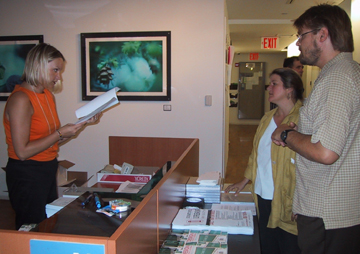
The engine that keeps the conference going, Heather Behnke,
discusses last
minute details with Debra Johnson, department chair of the
Pratt’s Industrial
Design department. (Pratt’s Prof. Scott Lundberg is
also part of the action.)
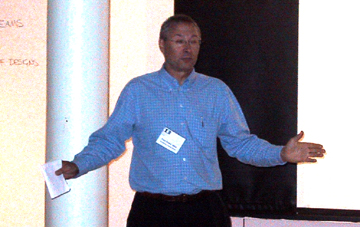 IDSA Vice President for the National Education Council, Paul
Down, is the P’
Diddy of design education (sans faux-gansta’ disposition,
clothing line, and
concealed weapons).
IDSA Vice President for the National Education Council, Paul
Down, is the P’
Diddy of design education (sans faux-gansta’ disposition,
clothing line, and
concealed weapons).
Bruce Hannah of Pratt Institute reflected upon the state of
design and what he
calls the trend toward ‘Karaoke design’—marked
by a lack of originality and
penchant for mimicry. He was able to draw upon the desire
to teach students to
dream—“about the future, not the past”—with
his participation in developing a
new Industrial Design program for an Idaho university. His
concern for
designing a program from scratch centered on the “act
of designing” rather than
a focus on form and the artifact itself.
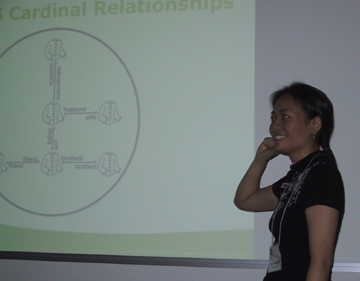
Ever wonder what it is like to do ethnographic research in
another culture, especially one as different (from the US) as
China? Elaine Ann, born and raised in Hong Kong, has worked
for 12 years in the US doing research for design consultancies
and corporations and now has her
own research firm that specializes in assisting western
companies interested in researching eastern users. While presenting
different models that affect the structure and methodology of
research in China, she debunks some common assumptions: local
translation is best, data base informant recruiting is best
(or possible), and talking to people is the same all over the
world—you can interview with the same techniques as in
the US.
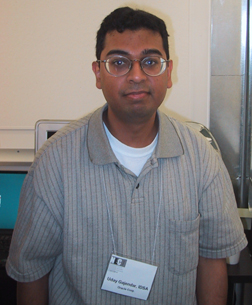
Another practicioner-presenter, Uday Gajendar draws upon his
experience with
Oracle’s usability and interface design group with his
paper, “Taking Care of
Business: A Model for Raising Business Consciousness among
Design Students.”
Gajendar creates a framework for students to understand the
practical aspects
of affecting positive user experiences. This is based upon
four distinct areas
where design and business cross paths: culture, leadership,
strategy, and
innovation.
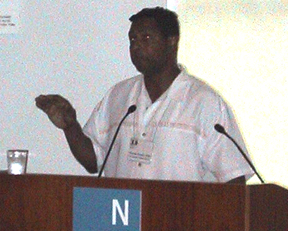
Ricardo Gomez discusses, “Teaching Universal Design.”
Having been involved
with universal design before it was cool and before it was
even known as
“universal design,” Gomez draws upon his past
and current work on the subject
at San Jose State. From what he calls “equity filters”
he proposes a framework
of Discovery (understanding), Interviewing (observing), Product
Analysis
(interpreting), Exploration (visualizing/realizing), User
Testing
(evaluating/refining), and Tangible Solution (implementing).
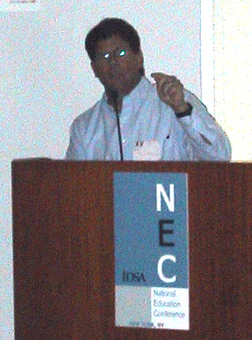
Drawing upon his kick-ass sketching and rendering prowess,
Kevin Reeder gave an
engaging talk about the use of anthropometrics and figure
drawing. His main
point is that incorporating the human figure and scale early
in the design
process saves time down the road. With numerous examples of
from his own and
his students’ work, he provides a convincing argument
for the power the pencil
and the incorporation of ergonomic issues at the front end.
Ed Dorsa hit on the hot topic of “Digital Technology
& Industrial Design
Education.” Voicing his belief that industrial design
education today cannot
be the same as it was even a decade ago because of digital
technology, he
argues against the “waste of time” involved with
traditional model making and
rendering. While not adverse to these skills outright, given
today’s
educational environment of “10 pounds of sand and a
5-pound bag” we should not
give concern to the ability to create appearance models and
renderings when
similarly effective information can be conveyed more efficiently
with digital
technology. He doesn’t care if his students use stereo
lothography for their
assignments and even tells them to “stop acting like
an artist.” Oooo, dems
is fightin’ words.
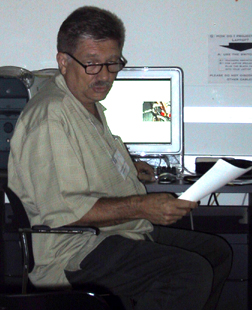
Donald Herring of Arizona State gave a fascinating talk about
“Design Research
Findings Related to Wheelchair Securement On Large Transit
Buses” that stemmed
from a student-based research project that was funded by the
National Institute
of Health-Small Business Innovation Research grant. Basically
they were
looking at how to better allow wheelchair users to secure
their wheelchairs on
city buses. Sound like a simple engineering problem? Far from
it—you can’t
even begin to think of the object-oriented solution until
the human and
institutional questions have been tackled. Their research
revealed the
seemingly insurmountable issues surrounding the attitudes
and sensitivities of
different wheelchair users, the bus other passengers, the
bus drivers who are
integral in the fastening process, city ordnances, discriminatory
and accident
litigation, liability insurance, and the Americans with Disabilities
Act
legislation. Herring suggests that other designers look into
Small Business
Innovation Research grants to fund real world projects, as
they got some fat
cash for just the initial phase of the project. (He is just
sitting down and is
not a wheelchair user himself…not that there is anything
wrong with that.)
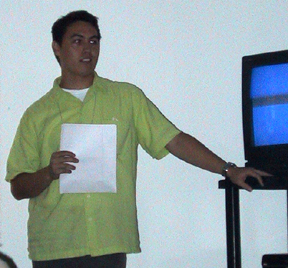
One-time students at Syracuse University, Chris Hosmer and
Heather Reavey now
are part of Design Continuum’s design strategy group.
Their talk dealt with
the Synergy Laboratory class at their Alma Matter that they
developed and which
is now entering its fourth year. Business, Architecture, and
Industrial Design
students join forces on projects affecting the school and
community. Some of
the lessons learned: 1) synergy is hard and communication
is clumsy, 2)
telling the story is paramount, 3) client accountability is
important, 4) a
good subject is key, 5) politics stink, 6) the user is not
the consumer, and 7)
enthusiasm is everything.
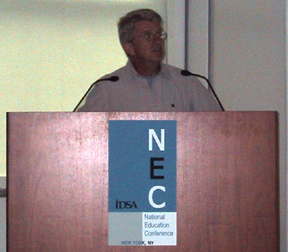
Ron Kenmitzer, 2003-04 visiting professor at Carnegie Mellon,
gave another
insightful and engaging presentation this year: “Are
You Talking to Me?” He
was also the only presenter to successfully incorporate the
word “fuck” into a
PowerPoint slide. He discussed the role of the user and his
framework for
incorporating their concerns in the product development process.
The user is
placed at the center of: Task Analysis, Human Factors, Cultural
Influences,
Scenarios, User Behavior, Intuition/Experience, Testing, and
User Profile.
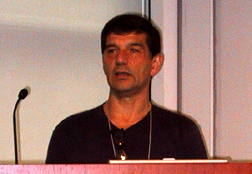
John Paul Kusz of Illinois Institute of Technology’s
Stuart Graduate School of
Business presented, “Balancing Sustainability in Product/Business
Models.”
Intelligent, well-educated, and with humanistic motivations,
Kusz introduced a
framework for re-envisioning and re-interpreting our material
world from the
business perspective. Moving from Waste Management (costing
money), to
Resource Management (saving money), to Asset Management (making
money) he
proposes a fundamental shift valid for bean counters and designers
alike. He
offered examples from a Chicago urban tree planting program
and such movements
from material to service-based offerings like the answering
machine to
voicemail and printed encyclopedias to MS Encarta.
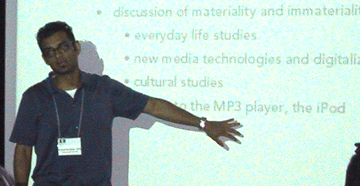
Arizona State’s Prasad Boradkar gave what I thought
was the best paper of the
conference, “Material Things, Immaterial Music.”
Engaging, robust, and cool,
his presentation incorporated theoretical issues from design
and material
culture studies in examining the production and consumption
of digital music
and the MP3 player. Specifically his study “seeks to
expand the social meaning
of the object, challenge the existing notions of the materiality
of technology,
examine the impact of genre-cultures on people and products,
and offer
multi-disciplinary approaches for doing so.”
Kara Johnson of IDEO and Jimmy Dickerson of Eastman Chemical
presented the
process and results of their recent collaboration on an exploration
of eyewear.
Touted as “The advance of design through materials,”
the conservative (nerdy?)
chemical engineers at Eastman joined forces with some of the
most creative
designers at IDEO to develop an amazing vision for the future
of eyewear. Be
it with copolyesters or cellulose their designs pushed the
limitations of
materials, processes, and the idea of what plastic on our
faces can be.
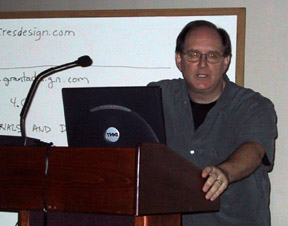
An anchor within the design education community, Craig Vogel
reminded us of the powerful example that Charles and Ray Eames
provide not only as deft practicioners but also as adroit
educators. Vogel himself was able to educate a room full of
educators, most of whom would claim to know a great deal about
the Eameses. By focusing on the lesser known films, rather
than their product design, we were left again invigorated
by the shining 20th Century example of effectiveness that
what we might hope to accomplish in the new millennium. Check
out their films at http://eamesoffice.com.
Also check out Vogel’s well-received new book, Creating
Breakthrough Products.
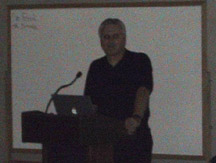
Bruce Claxton, current President of the IDSA talked about our
design community
and calls for increased involvement and outreach between students,
educators,
and practicioners despite the positive advances of recent
years.
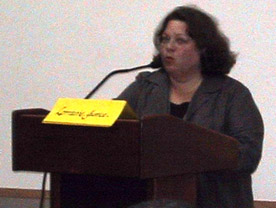
Lorraine Justice, PhD of Georgia Tech talked straight about
the sometimes
perilous journey toward academic tenure and how to avoid the
pitfalls.
Relationships, relationships, relationships.
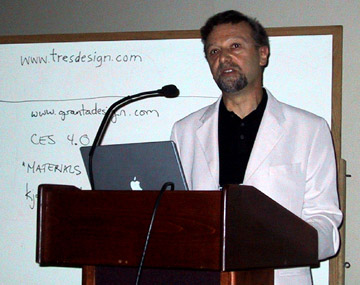
Stephen Meamed presentdc “Launching an Interdisciplinary
Product Development
Course at the University of Illinois at Chicago.” Like
the title says, he
spearheaded a two-semester research and design class which
was funded by
Whirlpool involving Industrial Design, Mechanical Engineering,
and
Marketing/Management students. Given the vague marching orders
of designing
for “Wellness in the home,” he describes the hurdles
involved at both
institutional and team levels in trying to bring “the
latest products to
market.”
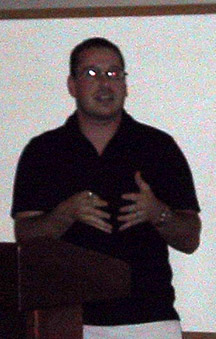
While David Rihgholz disagrees with Ricardo Gomez (above)
about the origins of
the Universal design movement (it’s like the east coast
vs. west coast rap
music quarrel less the drive-by shootings), they both agree
on the importance
of its place within Industrial Design curricula. In “Systems
Approach to
Universal Design Education,” Ringholz’s perspective
envisions the universal
design interaction system as the “combination of the
user, the procuct, the
task and the environment in which it all takes place.”
While this at the
surface seems obvious, his framework for how to interrogate
these areas is
helpful and is capable of offering inciting “audiences
outside of the product
design discipline; architecture, environmental design, engineering,
and
facility management to name only a few.”
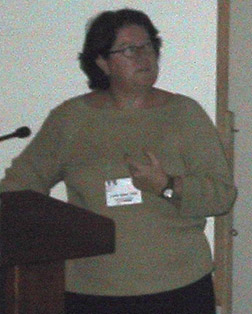
Leslie Speer of California College of Arts and Crafts carried
the Eco-Design
torch as she discusses her work in teaching eco-awareness
classes and
incorporating its principles in other, more general industrial
design courses.
She shared experiences over the last five years with her courses
that began as
three-day charrettes and matured into regular studio-based
projects. A staple
of her “From Trash to Cash” courses involves using
abundant and ubiquitously
discarded items (eg, plastic grocery bags, junk mail, and
aluminum cans) as raw
materials for other and potentially mass producible products.

This year’s interactive panel dealt with audience-raised
issues including the
state of design education, entrepreneurialism, the digital
classroom, and the
value of design in the market economy as well as its role
in improving the human condition.
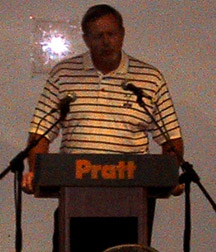
The NEC closing dinner was sponsored by the Eastman Chemical
Company (Pro-Tech
Powder Coating and Rhino were also conference sponsors—thanks!).
Here one of
their bigwigs thanks the IDSA for the collaboration and talks
about the wacky
plastic samples that were left on the dinner tables.
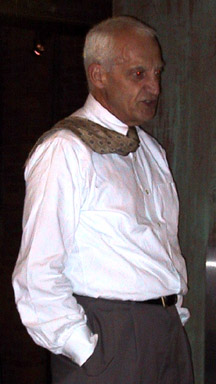
Pratt’s president, Thomas Schutte, addresses the dinner
crowd with the casual
tie-over-the-shoulder-so-it-won’t-get-in-my-roasted-rosemary-chicken
look.
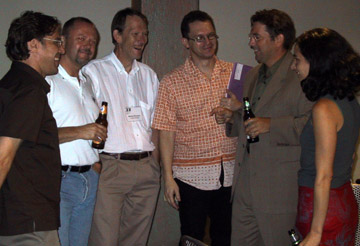
Canadian, Australian, and American educators unite in a coalition
of alcoholic consumption.
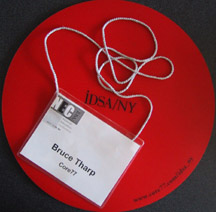
If you have any great ideas on how to reuse these old conference
name badges, please tell me and ReadyMade
magazine. I have piles of these things.
If
you have questions, comments, and/or complaints about the
above article please email me < brutha-at-core77.com
>
|



![]()

 IDSA Vice President for the National Education Council, Paul
Down, is the P’
Diddy of design education (sans faux-gansta’ disposition,
clothing line, and
concealed weapons).
IDSA Vice President for the National Education Council, Paul
Down, is the P’
Diddy of design education (sans faux-gansta’ disposition,
clothing line, and
concealed weapons). 


















